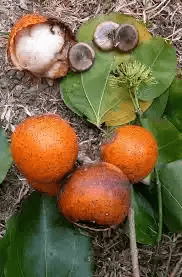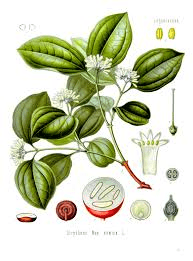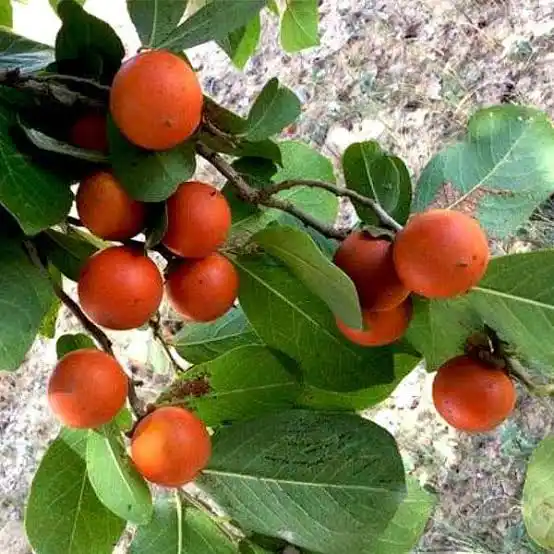Strychnos nux-vomica, commonly known as Strychnine tree, is a deciduous tree native to Southeast Asia. Recognized for its small, round fruits, it has a history of use in traditional medicine but is notorious for containing the toxic alkaloid strychnine.
The tree, with dark green, glossy leaves and fragrant, star-shaped flowers, reaches a moderate height. Its small, orange fruits house seeds that are the primary source of strychnine, making the plant potentially dangerous.
In traditional medicine, small doses of Nux Vomica were historically used to address various ailments. However, due to the potential toxicity of strychnine, modern medicine has largely moved away from using it as a therapeutic agent.
The toxic properties of Nux Vomica seeds can lead to severe poisoning, affecting the nervous system and causing convulsions. Handling all parts of the tree with care is crucial, and self-medication or home remedies involving Nux Vomica should be avoided.
Nux Vomica is more commonly known in contemporary contexts for its significance in homeopathy. Homeopathic preparations involving highly diluted amounts of Nux Vomica are believed by some to address specific health issues, but these claims remain a subject of debate within the medical community.
Cultivating Nux Vomica requires caution due to its toxicity, and it is mainly found in tropical and subtropical climates with well-draining soil. While it may be grown for ornamental purposes, its medicinal use is highly discouraged without proper expertise.
In conclusion, Strychnos nux-vomica, or Nux Vomica, is a tree with a complex reputation, known for its toxic properties and historical use in traditional medicine.
Caution is paramount when dealing with any part of this tree due to the presence of strychnine, and its contemporary applications, especially in homeopathy, remain a subject of scrutiny within the broader medical community.
The Botanical Description of Strychnos nux-vomica
1. Overview: Strychnos nux-vomica, commonly known as nux vomica, is a deciduous tree belonging to the Loganiaceae family. Renowned for its distinctive features and historical significance, this tree has played a role in traditional medicine but is also recognized for the toxicity of its seeds.
2. Height and Form: Nux vomica typically reaches a height of 12 to 15 meters, showcasing a moderately tall stature. The tree’s form is characterized by a straight trunk, which branches out into a broad and spreading crown. The overall appearance is symmetrical and aesthetically pleasing.
3. Leaves: The leaves of Strychnos nux-vomica are opposite, meaning they are arranged in pairs along the stem, and they are leathery in texture. The elliptical leaves have a glossy surface, providing an attractive display even when the tree is not in bloom.
4. Flowers: Nux vomica produces small, greenish-white flowers that bloom in clusters. While individually modest, the collective effect of these blossoms adds a delicate touch to the tree’s overall visual appeal. The flowering period is a notable phase in the tree’s annual cycle.
5. Fruits: The tree bears distinctive fruits that are round, smooth, and orange when ripe. These fruits are about the size of an apple and contain seeds. However, caution is warranted as the seeds of nux vomica are highly toxic due to the presence of strychnine and brucine.
The Geographic Distribution of Strychnos nux-vomica
1. Native Habitat: Strychnos nux-vomica is native to the Indian subcontinent, flourishing in the regions of India, Sri Lanka, and Southeast Asia. Its natural habitat includes both plains and lower hills, where the climate is conducive to its growth.
2. Global Presence: Due to its historical use in traditional medicine and the pharmaceutical industry, nux vomica has been introduced to various parts of the world. It can now be found in regions with tropical and subtropical climates, including parts of Africa, Australia, and the Caribbean.
3. Climate Preferences: Nux vomica thrives in tropical and subtropical climates, where temperatures are warm throughout the year. It is adaptable to a variety of soil types but prefers well-drained soil for optimal growth.
4. Cultivation Challenges: While nux vomica can be cultivated in different climates, it may face challenges in areas with extreme temperatures or inadequate rainfall. The tree is well-suited to regions with consistent warmth and moderate humidity.
5. Conservation Status: As a species utilized for its medicinal properties, the conservation status of Strychnos nux-vomica is a subject of concern. Sustainable harvesting practices and efforts to prevent overexploitation are crucial to maintain the ecological balance in its native habitats.
The Chemical Composition of Strychnos nux-vomica
1. Strychnine and Brucine: The seeds of nux vomica are notable for containing strychnine and brucine, alkaloids that are highly toxic to humans and animals. These alkaloids impact the central nervous system, leading to severe consequences if ingested in even small quantities.
2. Triterpenoids: Nux vomica also contains triterpenoid compounds, which contribute to the plant’s pharmacological properties. These compounds have been studied for their potential therapeutic effects, although their presence is overshadowed by the toxic alkaloids.
3. Indole Alkaloids: In addition to strychnine and brucine, nux vomica may contain other indole alkaloids with varying pharmacological activities. The complex chemical composition of the tree’s seeds has prompted research into potential medicinal applications, but caution is paramount due to the toxicity of its primary alkaloids.
4. Glycosides: Nux vomica is known to contain glycosides, compounds that may have physiological effects. These substances are part of the intricate chemical profile of the tree, contributing to its overall biological significance.
5. Pharmacological Effects: The chemical composition of Strychnos nux-vomica, particularly the presence of strychnine and brucine, has historically been harnessed for their stimulant effects on the central nervous system. However, their narrow therapeutic window and high toxicity have limited their practical applications.
Exploring the botanical description, geographic distribution, and chemical composition of Strychnos nux-vomica provides a comprehensive understanding of this tree’s unique characteristics and its significance in various fields, from traditional medicine to toxicology.
Read Also: Complete Guide on Sheep and Goats Production
The Medicinal Health Benefits Of Strychnos nux-vomica (Strychnine tree)

1. Analgesic Properties: Strychnos nux-vomica has been traditionally recognized for its potential analgesic properties. Compounds found in the plant may offer relief from pain, making it a subject of interest in traditional medicine for addressing various pain-related conditions.
2. Digestive Health Support: Nux vomica has been employed to promote digestive health. It may aid in enhancing digestion, reducing bloating, and relieving symptoms associated with indigestion. This property makes it a component in certain herbal formulations targeting gastrointestinal well-being.
3. Respiratory Health: Traditional uses of nux vomica include its application in addressing respiratory issues. The plant’s properties may help in managing conditions such as coughs and respiratory distress, contributing to overall respiratory health.
4. Stimulant for the Central Nervous System: While the primary alkaloids in nux vomica, strychnine, and brucine, are highly toxic, in controlled and diluted forms, they have been historically used as stimulants for the central nervous system. This property has been explored in traditional medicine for various applications.
5. Anti-Inflammatory Effects: Compounds in nux vomica may exhibit anti-inflammatory effects, contributing to its potential in alleviating inflammation-related conditions. This property is essential in promoting overall well-being and addressing inflammatory issues.
6. Antimicrobial Activity: Some studies suggest that nux vomica may possess antimicrobial properties. While further research is needed to validate these claims, the plant’s traditional use for addressing microbial infections indicates its historical significance in this context.
7. Cardiovascular Health: The plant’s chemical composition has been investigated for potential cardiovascular benefits. However, due to its toxicity, any exploration of nux vomica for cardiovascular health should be approached with extreme caution and under the supervision of healthcare professionals.
8. Antioxidant Properties: Certain constituents in nux vomica may exhibit antioxidant properties. Antioxidants play a crucial role in neutralizing free radicals in the body, potentially reducing oxidative stress and supporting cellular health.
The Methods of Usage to Achieve the Provided Health Benefits Of Strychnos nux-vomica (Strychnine tree)
1. Herbal Infusions: Nux vomica can be used to prepare herbal infusions. Dried or powdered forms of the plant can be steeped in hot water to create a tea. However, given its toxicity, the use of nux vomica for this purpose should be approached with extreme caution and preferably under the guidance of a qualified herbalist.
2. Topical Applications: In traditional medicine, diluted forms of nux vomica extracts have been used topically for certain conditions. However, due to its toxic nature, applying nux vomica topically should only be done under the guidance of a healthcare professional.
3. Tinctures: Tinctures, created by soaking nux vomica in alcohol or another solvent, provide a concentrated form of the plant. However, considering its toxicity, the preparation and usage of tinctures should be strictly regulated and monitored by healthcare professionals.
4. Homeopathic Preparations: Nux vomica is a key remedy in homeopathy, where highly diluted forms are used to stimulate the body’s natural healing processes. Homeopathic preparations should only be administered under the guidance of a qualified homeopathic practitioner.
5. Traditional Formulations: In certain traditional systems of medicine, nux vomica is included in specific formulations that aim to address various health concerns. However, the use of such formulations should be guided by experienced practitioners who are familiar with the potential risks and benefits.
6. Dietary Supplements: While not common, nux vomica may be available in the form of dietary supplements. If considering such supplements, it is crucial to consult with healthcare professionals to ensure proper dosage and minimize the risk of toxicity.
The Side Effects Of Using Strychnos nux-vomica Medicinal Plant
1. Toxicity: The primary concern associated with nux vomica is its high toxicity, primarily due to the presence of strychnine and brucine. Even small amounts of these alkaloids can lead to severe poisoning, affecting the central nervous system and leading to convulsions and respiratory failure.
2. Gastrointestinal Distress: Ingesting nux vomica, even in small quantities, can lead to gastrointestinal distress. Symptoms may include nausea, vomiting, and abdominal pain. In severe cases of poisoning, these symptoms can escalate rapidly.
3. Neurological Effects: The toxic alkaloids in nux vomica primarily affect the central nervous system. Symptoms of poisoning include muscle stiffness, spasms, and convulsions, leading to a potentially life-threatening condition.
4. Respiratory Failure: In cases of severe poisoning, nux vomica toxicity can lead to respiratory failure. This is a critical and potentially fatal consequence of ingesting even small amounts of the plant or its extracts.
5. Cardiovascular Issues: Due to its stimulant effects on the central nervous system, nux vomica toxicity can lead to cardiovascular issues, including elevated heart rate and blood pressure. In severe cases, these effects can contribute to cardiovascular collapse.
6. Allergic Reactions: While less common, some individuals may be sensitive or allergic to certain compounds in nux vomica. Allergic reactions may manifest as skin irritation, swelling, or respiratory symptoms.
Read Also: 24 Medicinal Health Benefits Of Garcinia Sessilis (Wild Mangosteen)
The Scientific Research and Studies of Strychnos nux-vomica

1. Toxicological Studies: Scientific research on Strychnos nux-vomica has predominantly focused on its toxicological aspects. Studies have delved into the toxic effects of its primary alkaloids, strychnine, and brucine, on the central nervous system. Understanding the mechanisms of toxicity is crucial for establishing safety guidelines and mitigating risks associated with the plant.
2. Pharmacological Investigations: Despite its toxicity, researchers have conducted pharmacological studies to explore potential therapeutic applications of nux vomica compounds. This includes investigating its effects on the central nervous system, cardiovascular system, and other physiological processes. However, the narrow therapeutic window and high toxicity limit practical applications.
3. Antimicrobial Properties: Some studies have explored the antimicrobial potential of Strychnos nux-vomica. While findings are preliminary, the research suggests that certain compounds in the plant may exhibit activity against microbial pathogens, providing a basis for further investigations into its potential in traditional medicine.
4. Phytochemical Analysis: Comprehensive phytochemical analyses have been conducted to identify and quantify the chemical constituents of nux vomica. This includes studying the presence of alkaloids, triterpenoids, glycosides, and other bioactive compounds. Understanding the plant’s chemical composition contributes to both its toxicological profile and potential therapeutic uses.
5. Homeopathic Research: Homeopathic preparations of nux vomica have been a subject of research in the field of alternative medicine. Studies have investigated the effects of highly diluted forms of the plant in various health conditions, emphasizing the principles of homeopathy in stimulating the body’s self-healing mechanisms.
The Safety Precautions and Recommendations In Using Strychnos nux-vomica Medicinal Plant
1. Professional Guidance: The foremost safety precaution in using nux vomica is seeking professional guidance. Whether considering traditional remedies, herbal formulations, or homeopathic preparations, consulting with qualified herbalists, homeopaths, or healthcare practitioners is essential. They can provide personalized advice based on individual health conditions.
2. Dosage Regulation: Due to the high toxicity of nux vomica, strict regulation of dosage is imperative. Only minimal amounts should be used, and the formulation and administration should be precise. Overconsumption, even in small quantities, can lead to severe poisoning.
3. Avoiding Self-Medication: Self-medication with nux vomica is strongly discouraged. Individuals should refrain from using the plant or its derivatives without professional guidance. This is especially important considering the potential for adverse effects and toxicity.
4. Identification of Authentic Sources: Ensuring that nux vomica products are sourced from reputable and authentic suppliers is crucial. This helps minimize the risk of contamination and ensures the quality and purity of the plant material used in formulations.
5. Allergy Testing: Before incorporating any form of nux vomica into a health regimen, individuals should undergo allergy testing. This is particularly relevant for topical applications or herbal infusions, where sensitivity to the plant’s compounds may vary among individuals.
6. Pregnancy and Breastfeeding Precautions: Pregnant and breastfeeding individuals should strictly avoid the use of nux vomica due to its toxicity. The potential risks to both maternal health and fetal development make it an unsuitable choice during these periods.
7. Monitoring for Adverse Reactions: Continuous monitoring for adverse reactions is essential when using nux vomica. Any signs of gastrointestinal distress, neurological symptoms, or allergic reactions should prompt immediate cessation of use, and medical attention should be sought.
FAQs About Strychnos nux-vomica. Medicinal Plant
1. Is nux vomica safe for self-medication?
No, self-medication with nux vomica is strongly discouraged due to its high toxicity. Professional guidance is essential to ensure safe and appropriate use.
2. Can nux vomica be used during pregnancy?
No, pregnant individuals should avoid the use of nux vomica due to its potential for adverse effects on maternal and fetal health.
3. Are there alternative remedies with less toxicity?
Yes, there are numerous alternative remedies with lower toxicity profiles that can address similar health concerns. Consulting with healthcare professionals can help identify safer alternatives.
4. How can one identify authentic nux vomica products?
Authenticity can be ensured by sourcing nux vomica products from reputable suppliers and adhering to quality standards. Look for certifications and transparent sourcing practices.
5. Are there non-toxic uses of nux vomica in traditional medicine?
While traditional medicine has historically utilized nux vomica, its toxicity restricts its practical use. Exploration of alternative herbs with similar therapeutic properties is advisable.
Navigating the safety considerations and frequently asked questions about Strychnos nux-vomica is crucial for promoting responsible and informed use, safeguarding against potential risks, and guiding individuals in seeking appropriate healthcare advice.

